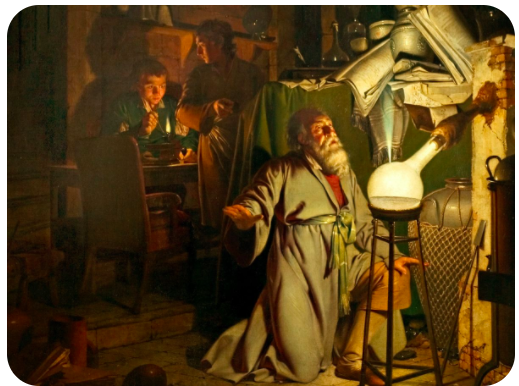Culture of Chemistry (1)
The Culture of Chemistry quizzes illustrate some of the Nature of Science aspects of the course. They aim to widen your general knowledge about our subject and give you some genuine examples of how chemistry works practically both now and in the past in everyday life as well as theoretically. Each quiz consists of ten multiple choice questions. Full answers and explanations are provided to hopefully increase your enjoyment and love of chemistry as well as stimulate your interest to perhaps do some further research.
Introduction
This is the first of the Culture of Chemistry quizzes. The quizzes have several aims. Essentially they illustrate some of the Nature of Science aspects of the course. They may also be helpful for your study of Theory of Knowledge as culture is one of the twelve TOK concepts. The questions are unlikely to contain content that will be examined as such in the May/November examination sessions but they aim to widen your general knowledge about our subject and give you some genuine examples of how chemistry works practically both now and in the past in everyday life as well as theoretically. They are meant to be fun and perhaps in these current Covid times also provide a little bit of light relief. I would not expect you to know many of the answers so the score you get is irrelevant but I have provided fulsome answers and explanations to hopefully increase your enjoyment and love of chemistry as well as stimulate your interest to perhaps do some further research. Some of the questions may provide you with the spark of an idea that you could develop for your individual scientific investigation (IA) or extended essay.
Culture of Chemistry (1) Quiz
Clara Helene Immerwahr, who had a doctorate in chemistry, took her own life on 2 May 1915, shortly after her husband had developed and supervised the first use of poison gas in the First World War at the Second Battle of Ypres. Who was her husband?
Victor Grignard researched phosgene and mustard gas for the French army in the First World War but this came after the use of chlorine by the German army at Ypres in 1915. The use of chlorine as a weapon of mass destruction was developed by Fritz Haber who also supervised its release in the trenches. Rutherford and Moseley worked together on the structure of atoms. Moseley who used X-rays to show the importance of atomic number was killed at the Battle of Gallipoli on 10 August 1915.
This black and white photograph titled “Rue Mouffettard” was taken by the French photographer Henri Cartier-Bresson in 1952.

Which chemical can be used to ‘fix’ black and white photographs to stop them from reacting further with light?
When light falls on silver bromide in a photographic film it converts the silver ions into metallic silver. This reduction process is further enhanced when the film is developed using a reducing agent such as hydroquinone. Once the desired level of reduction is achieved the development process is halted by washing in a dilute acid, such as ethanoic acid, and then the undeveloped silver bromide is removed by dissolving it in a thiosulfate solution, a process called fixing. The reaction between silver bromide and sodium thiosulfate is AgBr(s) + 2Na2S2O3(aq) → Na3Ag(S2O3)2(aq) + NaBr(aq). The film is then washed in water to remove all the soluble salts. The printing of the positive photograph from the negative image on the film follows a similar process.
Serendipity played a major role in the discovery of which drug?
Serendipity requires both a chance event and the mental ability to understand the occurrence and realise its potential. Many drugs such as penicillin and sulphanilamide have been discovered by serendipity. Cis-platin, PtCl2(NH3)2, was discovered through serendipity when Barnett Rosenberg noticed in 1965 that when he used platinum electrodes to pass electricity through a solution of bacteria, the bacterial cells stopped dividing, although they kept growing to up to 300 times their normal length. He assumed the platinum was inert (which is why he chose to use it for the electrodes) and initially thought the effect was due to the electric current. It was only later that he realised that a compound cis-platin was being formed at the electrodes and it was this that stopped the cells dividing. Cis-platin is now a very effective drug against testicular cancer and other forms of cancer.
Who is the only person to have been awarded the Nobel Prize in Chemistry and the Nobel Peace Prize?
Linus Pauling was awarded the Nobel Prize in Chemistry in 1954 for his work on bonding. This included the concepts of hybridization, the electronegativities of the elements and the structures of proteins. In 1962 he was awarded the Nobel Peace Prize for his work campaigning against the above-ground testing of nuclear weapons and the spread of nuclear weapons. Marie Curie also was awarded two Nobel Prizes (in Physics in 1903 and in Chemistry in 1911). She is still the only woman to have won the Nobel Prize twice.
William Perkin made the serendipitous discovery of the first synthetic organic dye in 1856 which helped to revolutionise the world of fashion. The dye was based on aniline and called mauveine. What was Perkin actually trying to achieve at the time?
William Perkin was only aged 18 when he was working under the instruction of Hofmann at what is now Imperial College London. He was asked to try to synthesise quinine from aniline. Whilst working at home he produced a substance with an intense purple colour. This was the first aniline dye and Perkin set up a factory to develop and mIB Docs (2) Teamfacture the dye.
The pH scale was introduced by Søren Sørensen as a way of expressing the hydrogen ion concentration (acidity) in simple numbers by using a logarithmic scale. In what industry did Sørensen work?
Søren Sørensen (1868 – 1939) was a Danish chemist who worked in the Carlsberg brewery laboratory in Copenhagen. He devised the pH system in 1909.
In the mid to late 1960’s element (z = 104) had the symbol Ku. Later this was changed to Rf.
Who or what was the element named after?

The element Kurchatov (symbol Ku) was discovered in 1964 by nuclear scientists working at the Joint Institute of Soviet Research in the USSR by bombarding plutonium-242 with neon-22. In 1969 the element was independently synthesised in the University of California, Berkeley by bombarding californium-249 with carbon-12. As the Americans were the first to publish they claimed the right to name it and called it Rutherfordium. In 1997 IUPAC formally agreed on the name Rutherfordium (Rf) but honoured the Soviets by naming element 105 Dubnium (symbol Db) after Dubna, the site of the Joint Institute of Soviet Research.
Which fact about oxygen is not consistent with the Lewis structure of oxygen?

In the Lewis structure of oxygen all the electrons are in pairs whereas paramagnetism is associated with unpaired electrons. The Lewis theory of bonding whereby atoms share their valence electrons to try to achieve a noble gas electron configuration is a simplified theory based on the false assumption that all the electrons in a valence shell are identical, whereas in reality they exist in sub-levels with different energies.
Which element was discovered by the alchemist Hennig Brandt while he was attempting to create the philosopher’s stone?
In 1669 Brandt was attempting to create the philosopher’s stone (which could transform base metals such as lead into gold) by heating strongly a mixture of sand and charcoal with a distillate obtained from about 1,200 gallons of urine. He produced a white substance which gleamed in the air. He named it phosphorus after the Latin term for giving off light. Brandt thought it was composed of a mixture of the four known elements at the time, fire, earth, air and water. It was not until Lavoisier defined an element more than one hundred years later that the significance of the accidental discovery was realised.

'The Alchemist, in Search of the Philosopher's Stone' by Joseph Wright of Derby showing the discovery of phosphorus.
What technique was used to prove beyond reasonable doubt that bones found in Magdeburg Cathedral in Germany belonged to the former Anglo-Saxon Princess Eadgyth?
.jpg)
A statue of Queen Eadgyth
Eadgyth was the granddaughter of Alfred the Great and is known to have to have married Otto the son of Henry, King of Saxony which was part of the German empire in 929 AD. When Henry died in 936 AD Otto became king of Germany and Eadgyth ruled as his queen until she died in 946 AD.
Strontium is absorbed by the body through soils and through the food chain where it substitutes for calcium. Depending on its source the ratio of 87Sr to 86Sr varies. As the strontium is absorbed by the body it becomes fixed in tooth enamel as the person grows thus providing a permanent record of the environment that the person grew up in. Analysis of the 87Sr to 86Sr ratio of the teeth found in her tomb in Magdeburg confirmed that she had spent the early part of her childhood in southern England.

 IB Docs (2) Team
IB Docs (2) Team